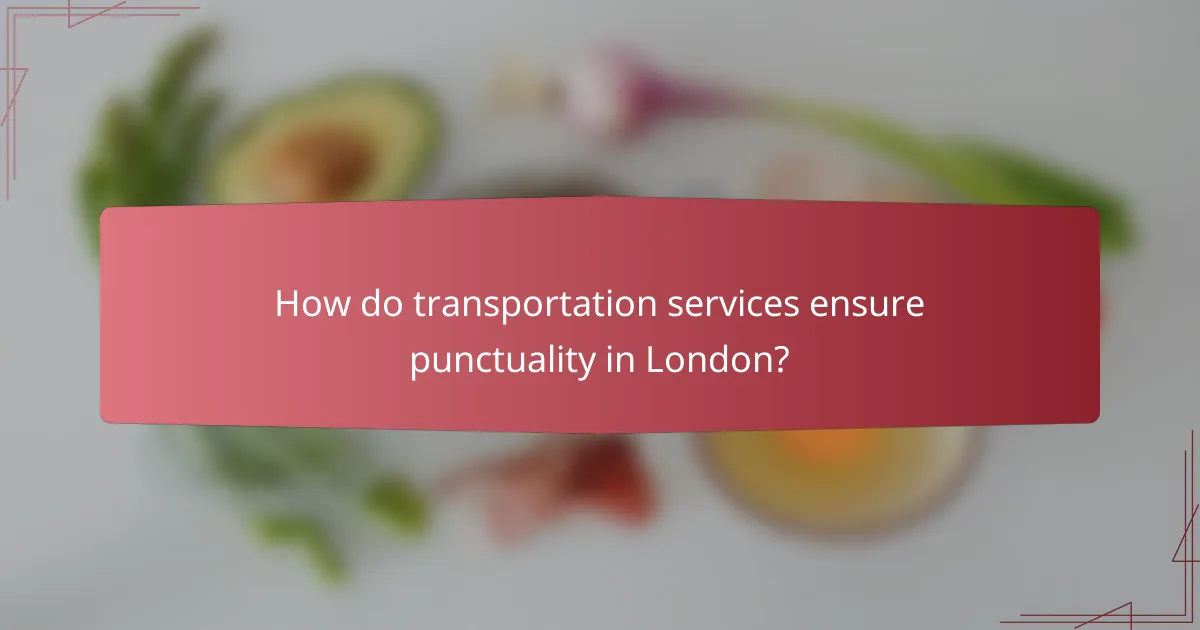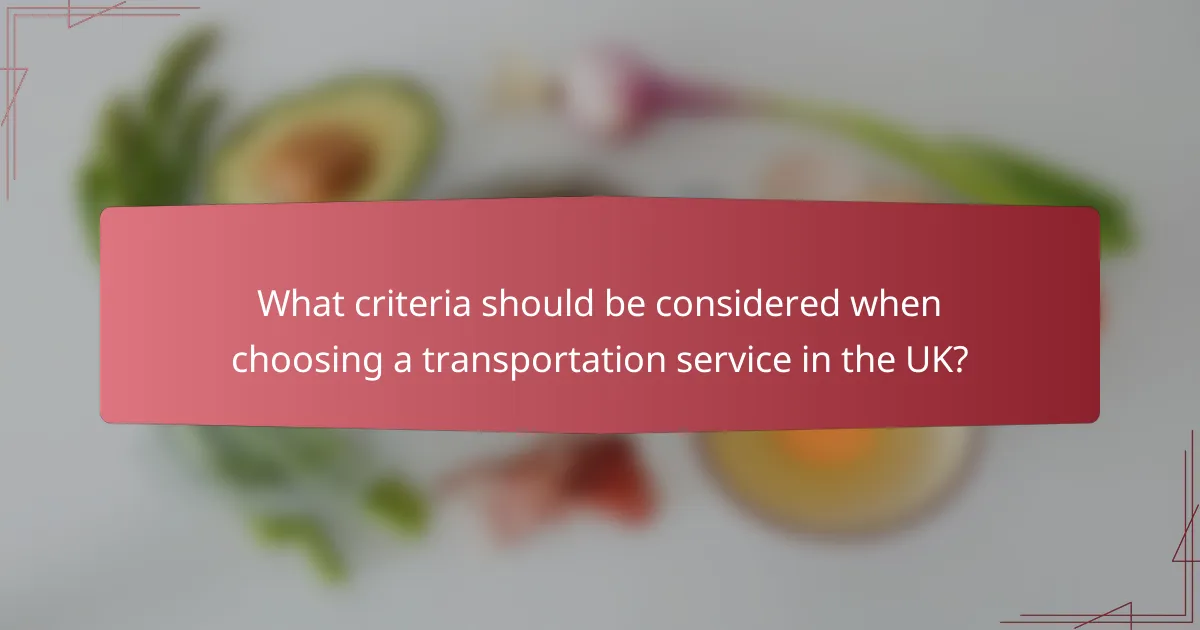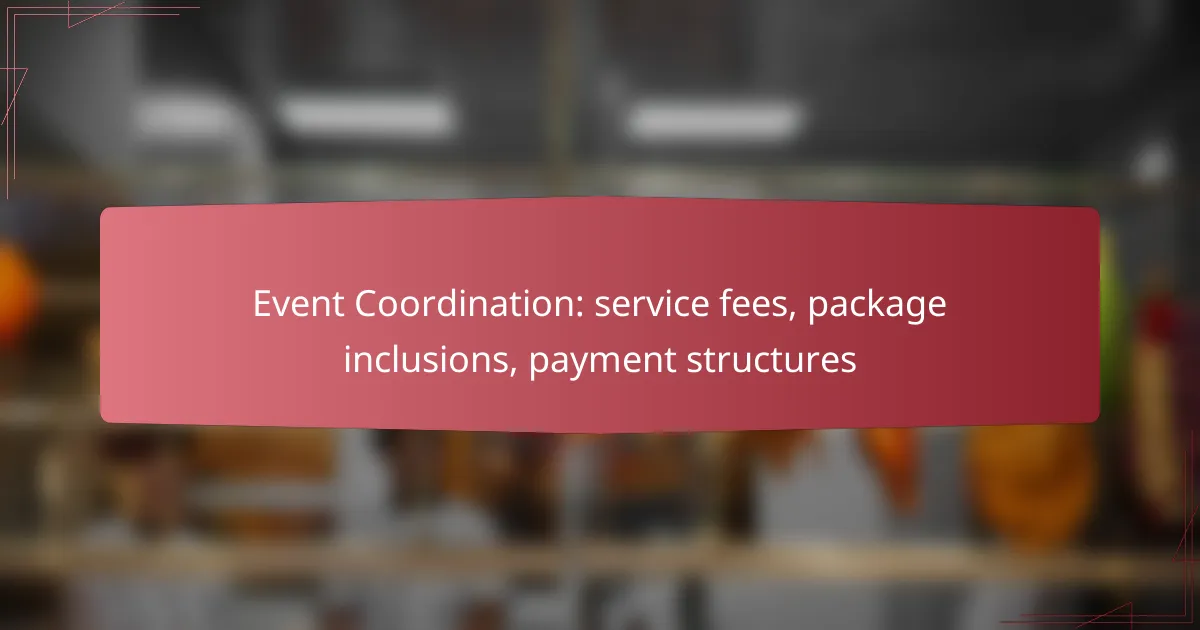Transportation services prioritize punctuality and guest convenience by utilizing advanced technology and dedicated personnel. By focusing on efficient route planning and real-time adjustments, these services enhance the overall travel experience, ensuring timely arrivals and a comfortable journey for all passengers.

How do transportation services ensure punctuality in London?
Transportation services in London ensure punctuality through a combination of advanced technology, dedicated personnel, and systematic maintenance practices. These elements work together to minimize delays and enhance the overall travel experience for passengers.
Real-time tracking systems
Real-time tracking systems are essential for maintaining punctuality in London’s transportation services. These systems utilize GPS technology to monitor vehicle locations and provide live updates to both operators and passengers. By offering accurate arrival times, they help manage expectations and reduce wait times.
Passengers can access tracking information through mobile apps or digital displays at stations, allowing them to plan their journeys more effectively. This transparency is crucial in a bustling city where traffic conditions can change rapidly.
Dedicated traffic management teams
Dedicated traffic management teams play a vital role in ensuring that transportation services remain punctual. These teams analyze traffic patterns and coordinate with drivers to optimize routes, especially during peak hours. Their proactive approach helps to mitigate delays caused by congestion or accidents.
In London, traffic management teams often collaborate with local authorities to implement temporary measures, such as road closures or diversions, to maintain smooth traffic flow. This collaboration is key to minimizing disruptions and ensuring timely arrivals.
Scheduled maintenance checks
Scheduled maintenance checks are critical for preventing breakdowns that can lead to delays in transportation services. Regular inspections of vehicles and infrastructure ensure that everything operates smoothly and safely. In London, these checks are often mandated by regulatory bodies to uphold safety standards.
Transportation companies typically follow a strict maintenance schedule, addressing issues before they escalate. This proactive approach not only enhances punctuality but also improves overall service reliability for passengers.

What are the benefits of guest convenience in transportation services?
Guest convenience in transportation services enhances the overall travel experience by prioritizing comfort, accessibility, and satisfaction. By focusing on these aspects, transportation providers can improve punctuality and ensure that guests feel valued throughout their journey.
Comfortable seating arrangements
Comfortable seating arrangements are crucial for a pleasant travel experience. Options such as spacious seats, adjustable headrests, and adequate legroom can significantly reduce fatigue during long journeys. Many transportation services now offer varying classes of seating, allowing guests to choose based on their budget and comfort preferences.
For instance, premium services may provide reclining seats with extra padding, while standard options might focus on maximizing seating capacity. It’s essential for travelers to consider their comfort needs when selecting transportation, especially for longer trips.
Accessible booking platforms
Accessible booking platforms streamline the process of reserving transportation, making it easier for guests to secure their travel plans. User-friendly websites and mobile apps allow for quick comparisons of routes, prices, and schedules, ensuring that guests can make informed decisions.
Transportation providers should prioritize intuitive designs and multiple payment options, including credit cards and digital wallets, to cater to a diverse clientele. Additionally, offering customer support through chat or phone can enhance accessibility for those who may need assistance during the booking process.
Onboard amenities
Onboard amenities play a significant role in enhancing guest convenience during travel. Services such as Wi-Fi, charging ports, refreshments, and entertainment options can make journeys more enjoyable and productive. Transportation companies that invest in these features often see higher customer satisfaction and loyalty.
When choosing a transportation service, guests should consider the available amenities that align with their needs. For example, business travelers may prioritize Wi-Fi and power outlets, while families might look for entertainment options for children. Understanding the amenities offered can help travelers select the best service for their journey.

How is route planning optimized for efficiency?
Route planning is optimized for efficiency by leveraging advanced technologies and data analysis to minimize travel time and enhance guest convenience. This process involves real-time adjustments based on traffic conditions and predictive modeling to ensure timely arrivals.
Use of GPS navigation
GPS navigation plays a crucial role in route planning by providing real-time location data and optimal path suggestions. It allows transportation services to track vehicles and adjust routes dynamically based on current conditions.
For instance, a transportation service can use GPS to reroute a vehicle if it detects heavy traffic ahead, ensuring that passengers reach their destination as quickly as possible. This technology is essential for maintaining punctuality and improving overall service quality.
Data analysis for traffic patterns
Analyzing traffic patterns helps transportation services anticipate congestion and adjust routes accordingly. By examining historical data, companies can identify peak traffic times and common bottlenecks, allowing them to plan more effective routes.
For example, if a particular road is known to be congested during rush hour, services can schedule trips to avoid that area during those times. Utilizing data analytics can lead to significant improvements in travel efficiency and customer satisfaction.
Dynamic route adjustments
Dynamic route adjustments enable transportation services to respond to changing conditions in real time. This flexibility is vital for maintaining punctuality, especially in urban areas where traffic can be unpredictable.
Services can implement algorithms that automatically adjust routes based on live traffic updates, weather conditions, or unexpected road closures. This proactive approach not only enhances efficiency but also ensures a smoother experience for guests, reducing wait times and improving overall satisfaction.

What criteria should be considered when choosing a transportation service in the UK?
When selecting a transportation service in the UK, consider factors such as service reliability, customer reviews, and pricing transparency. These criteria will help ensure a smooth and satisfactory travel experience.
Service reliability
Service reliability refers to the punctuality and consistency of a transportation provider. Look for services that have a strong track record of on-time arrivals and departures, as delays can significantly impact your travel plans.
Check if the service offers real-time tracking and updates, which can enhance your travel experience by keeping you informed about any changes. A reliable service often has contingency plans for unexpected situations, such as traffic or weather disruptions.
Customer reviews
Customer reviews provide insights into the experiences of others who have used the transportation service. Look for services with consistently positive feedback regarding their reliability, comfort, and overall customer service.
Platforms like Trustpilot or Google Reviews can be valuable resources for assessing customer satisfaction. Pay attention to recurring themes in reviews, such as punctuality or driver professionalism, to gauge the service’s strengths and weaknesses.
Pricing transparency
Pricing transparency is crucial when choosing a transportation service, as it helps you understand the total cost of your journey. Ensure that the service provides clear information about fares, including any additional fees for luggage or peak times.
Compare pricing across different providers to find a service that offers good value without hidden charges. A transparent pricing model allows you to make informed decisions and avoid unexpected costs during your travel.

How do transportation services handle permits and regulations?
Transportation services manage permits and regulations by adhering to local laws, conducting regular audits, and collaborating with regulatory bodies. These practices ensure compliance and enhance operational efficiency while prioritizing safety and reliability.
Compliance with local laws
Transportation services must comply with various local laws that govern operations, including licensing, safety standards, and environmental regulations. For instance, a taxi service in New York City must obtain a medallion and follow specific fare regulations set by the Taxi and Limousine Commission.
Understanding these laws is crucial for avoiding penalties and ensuring smooth operations. Companies often need to stay updated on changes in regulations, which can vary significantly by region.
Regular audits and inspections
Regular audits and inspections are essential for maintaining compliance with permits and regulations. Transportation services typically schedule these assessments to evaluate their adherence to safety and operational standards.
These audits can be internal or conducted by third-party organizations. They often involve checking vehicle conditions, driver qualifications, and adherence to operational protocols, helping to identify areas for improvement.
Partnerships with regulatory bodies
Establishing partnerships with regulatory bodies can facilitate smoother operations for transportation services. These relationships allow companies to gain insights into regulatory changes and best practices, fostering a collaborative approach to compliance.
For example, a bus company might work closely with the local transportation authority to ensure that its routes align with city planning and safety regulations. This proactive engagement can help mitigate compliance risks and enhance service reliability.



